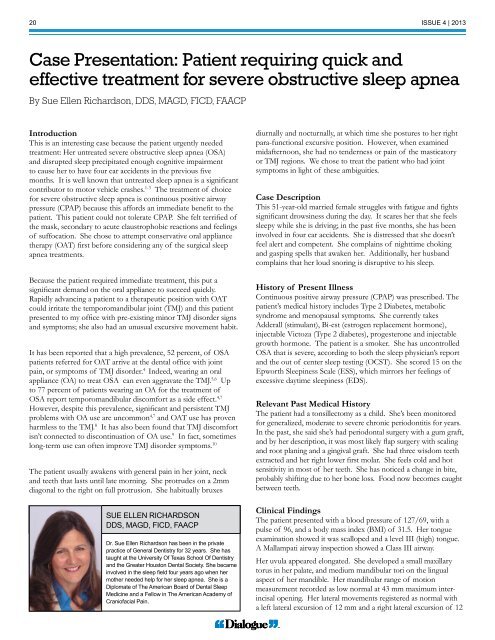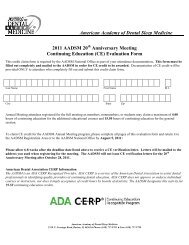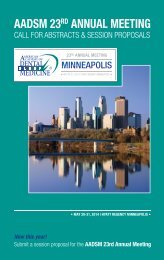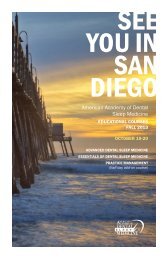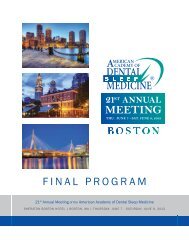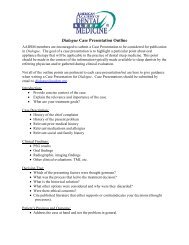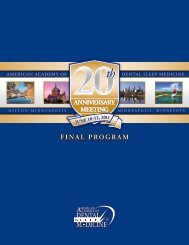In this issue - The American Academy of Dental Sleep Medicine
In this issue - The American Academy of Dental Sleep Medicine
In this issue - The American Academy of Dental Sleep Medicine
You also want an ePaper? Increase the reach of your titles
YUMPU automatically turns print PDFs into web optimized ePapers that Google loves.
20<br />
ISSUE 4 | 2013<br />
Case Presentation: Patient requiring quick and<br />
effective treatment for severe obstructive sleep apnea<br />
By Sue Ellen Richardson, DDS, MAGD, FICD, FAACP<br />
<strong>In</strong>troduction<br />
This is an interesting case because the patient urgently needed<br />
treatment: Her untreated severe obstructive sleep apnea (OSA)<br />
and disrupted sleep precipitated enough cognitive impairment<br />
to cause her to have four car accidents in the previous five<br />
months. It is well known that untreated sleep apnea is a significant<br />
contributor to motor vehicle crashes. 1-3 <strong>The</strong> treatment <strong>of</strong> choice<br />
for severe obstructive sleep apnea is continuous positive airway<br />
pressure (CPAP) because <strong>this</strong> affords an immediate benefit to the<br />
patient. This patient could not tolerate CPAP. She felt terrified <strong>of</strong><br />
the mask, secondary to acute claustrophobic reactions and feelings<br />
<strong>of</strong> suffocation. She chose to attempt conservative oral appliance<br />
therapy (OAT) first before considering any <strong>of</strong> the surgical sleep<br />
apnea treatments.<br />
Because the patient required immediate treatment, <strong>this</strong> put a<br />
significant demand on the oral appliance to succeed quickly.<br />
Rapidly advancing a patient to a therapeutic position with OAT<br />
could irritate the temporomandibular joint (TMJ) and <strong>this</strong> patient<br />
presented to my <strong>of</strong>fice with pre-existing minor TMJ disorder signs<br />
and symptoms; she also had an unusual excursive movement habit.<br />
It has been reported that a high prevalence, 52 percent, <strong>of</strong> OSA<br />
patients referred for OAT arrive at the dental <strong>of</strong>fice with joint<br />
pain, or symptoms <strong>of</strong> TMJ disorder. 4 <strong>In</strong>deed, wearing an oral<br />
appliance (OA) to treat OSA can even aggravate the TMJ. 5,6 Up<br />
to 77 percent <strong>of</strong> patients wearing an OA for the treatment <strong>of</strong><br />
OSA report temporomandibular discomfort as a side effect. 4,7<br />
However, despite <strong>this</strong> prevalence, significant and persistent TMJ<br />
problems with OA use are uncommon 4,7 and OAT use has proven<br />
harmless to the TMJ. 8 It has also been found that TMJ discomfort<br />
isn’t connected to discontinuation <strong>of</strong> OA use. 9 <strong>In</strong> fact, sometimes<br />
long-term use can <strong>of</strong>ten improve TMJ disorder symptoms. 10<br />
<strong>The</strong> patient usually awakens with general pain in her joint, neck<br />
and teeth that lasts until late morning. She protrudes on a 2mm<br />
diagonal to the right on full protrusion. She habitually bruxes<br />
SUE ELLEN RICHARDSON<br />
DDS, MAGD, FICD, FAACP<br />
Dr. Sue Ellen Richardson has been in the private<br />
practice <strong>of</strong> General Dentistry for 32 years. She has<br />
taught at the University Of Texas School Of Dentistry<br />
and the Greater Houston <strong>Dental</strong> Society. She became<br />
involved in the sleep field four years ago when her<br />
mother needed help for her sleep apnea. She is a<br />
Diplomate <strong>of</strong> <strong>The</strong> <strong>American</strong> Board <strong>of</strong> <strong>Dental</strong> <strong>Sleep</strong><br />
<strong>Medicine</strong> and a Fellow in <strong>The</strong> <strong>American</strong> <strong>Academy</strong> <strong>of</strong><br />
Crani<strong>of</strong>acial Pain.<br />
diurnally and nocturnally, at which time she postures to her right<br />
para-functional excursive position. However, when examined<br />
midafternoon, she had no tenderness or pain <strong>of</strong> the masticatory<br />
or TMJ regions. We chose to treat the patient who had joint<br />
symptoms in light <strong>of</strong> these ambiguities.<br />
Case Description<br />
This 51-year-old married female struggles with fatigue and fights<br />
significant drowsiness during the day. It scares her that she feels<br />
sleepy while she is driving; in the past five months, she has been<br />
involved in four car accidents. She is distressed that she doesn’t<br />
feel alert and competent. She complains <strong>of</strong> nighttime choking<br />
and gasping spells that awaken her. Additionally, her husband<br />
complains that her loud snoring is disruptive to his sleep.<br />
History <strong>of</strong> Present Illness<br />
Continuous positive airway pressure (CPAP) was prescribed. <strong>The</strong><br />
patient’s medical history includes Type 2 Diabetes, metabolic<br />
syndrome and menopausal symptoms. She currently takes<br />
Adderall (stimulant), Bi-est (estrogen replacement hormone),<br />
injectable Victoza (Type 2 diabetes), progesterone and injectable<br />
growth hormone. <strong>The</strong> patient is a smoker. She has uncontrolled<br />
OSA that is severe, according to both the sleep physician’s report<br />
and the out <strong>of</strong> center sleep testing (OCST). She scored 15 on the<br />
Epworth <strong>Sleep</strong>iness Scale (ESS), which mirrors her feelings <strong>of</strong><br />
excessive daytime sleepiness (EDS).<br />
Relevant Past Medical History<br />
<strong>The</strong> patient had a tonsillectomy as a child. She’s been monitored<br />
for generalized, moderate to severe chronic periodontitis for years.<br />
<strong>In</strong> the past, she said she’s had periodontal surgery with a gum graft,<br />
and by her description, it was most likely flap surgery with scaling<br />
and root planing and a gingival graft. She had three wisdom teeth<br />
extracted and her right lower first molar. She feels cold and hot<br />
sensitivity in most <strong>of</strong> her teeth. She has noticed a change in bite,<br />
probably shifting due to her bone loss. Food now becomes caught<br />
between teeth.<br />
Clinical Findings<br />
<strong>The</strong> patient presented with a blood pressure <strong>of</strong> 127/69, with a<br />
pulse <strong>of</strong> 96, and a body mass index (BMI) <strong>of</strong> 31.5. Her tongue<br />
examination showed it was scalloped and a level III (high) tongue.<br />
A Mallampati airway inspection showed a Class III airway.<br />
Her uvula appeared elongated. She developed a small maxillary<br />
torus in her palate, and medium mandibular tori on the lingual<br />
aspect <strong>of</strong> her mandible. Her mandibular range <strong>of</strong> motion<br />
measurement recorded as low normal at 43 mm maximum interincisal<br />
opening. Her lateral movements registered as normal with<br />
a left lateral excursion <strong>of</strong> 12 mm and a right lateral excursion <strong>of</strong> 12


